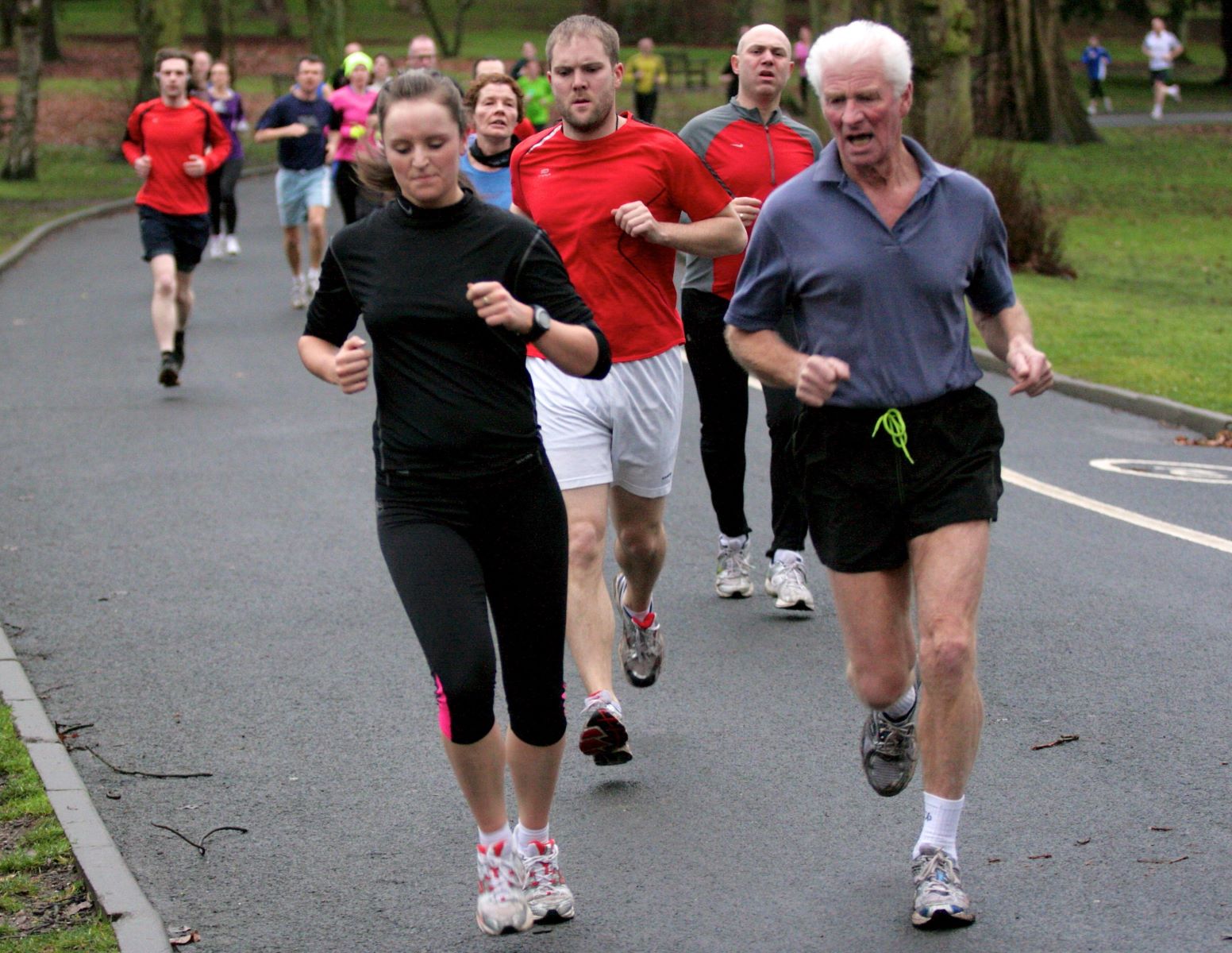Home>Training & Techniques>10 Running Workouts To Assess Your Fitness Level


Training & Techniques
10 Running Workouts To Assess Your Fitness Level
Published: March 1, 2024
"Discover 10 effective running workouts to evaluate your fitness level. Learn essential training and techniques for optimal performance."
(Many of the links in this article redirect to a specific reviewed product. Your purchase of these products through affiliate links helps to generate commission for Therunningadvisor.com, at no extra cost. Learn more)
Table of Contents
- Introduction
- The Importance of Assessing Your Fitness Level
- Workout 1: Interval Sprints
- Workout 2: Hill Repeats
- Workout 3: Tempo Runs
- Workout 4: Long Distance Run
- Workout 5: Fartlek Training
- Workout 6: Track Workouts
- Workout 7: Stair Climbing
- Workout 8: Cross Training
- Workout 9: Time Trials
- Workout 10: Recovery Runs
Introduction
Assessing your fitness level is a crucial aspect of any training program. It provides valuable insights into your current physical condition, helps set realistic goals, and guides the development of an effective workout plan. Whether you are a seasoned athlete or a fitness enthusiast embarking on a new journey, understanding where you stand in terms of fitness is essential for progress and overall well-being.
By evaluating your fitness level, you gain a clear understanding of your strengths and areas that require improvement. This knowledge empowers you to tailor your workouts to address specific weaknesses and enhance your overall performance. Additionally, regularly assessing your fitness level allows you to track your progress over time, providing motivation and a sense of accomplishment as you witness improvements in various aspects of your physical fitness.
In this article, we will explore ten diverse running workouts that can serve as effective tools for assessing your fitness level. Each workout offers unique challenges and targets different aspects of physical fitness, providing valuable insights into your cardiovascular endurance, speed, strength, and overall running proficiency. By incorporating these workouts into your training regimen, you can gain a comprehensive understanding of your current fitness level and identify areas for improvement.
Whether you are aiming to enhance your endurance for a marathon, improve your speed for a 5K race, or simply maintain a healthy level of fitness, these running workouts will serve as valuable assessment tools. From interval sprints to tempo runs, each workout presents an opportunity to push your limits, gauge your performance, and make informed decisions about your training approach.
As we delve into each workout, you will discover how they can be utilized to assess different aspects of your fitness, providing valuable feedback that can inform your training progression. By embracing the challenge of these diverse running workouts, you will not only gain insights into your current fitness level but also embark on a journey of self-discovery and continuous improvement.
Now, let's embark on this insightful journey and explore the diverse running workouts that can help you assess your fitness level and elevate your training experience.
The Importance of Assessing Your Fitness Level
Assessing your fitness level is a critical component of any effective training regimen. It serves as a foundational step in understanding your current physical capabilities and plays a pivotal role in shaping your fitness journey. By evaluating your fitness level, you gain valuable insights that can guide your training approach, help set realistic goals, and track your progress over time.
One of the primary benefits of assessing your fitness level is the ability to gain a comprehensive understanding of your strengths and areas that require improvement. This self-awareness empowers you to tailor your workouts to address specific weaknesses and capitalize on your strengths, leading to a more balanced and effective training program. Whether you are striving to improve your cardiovascular endurance, increase your speed, or enhance your overall strength, assessing your fitness level provides a clear roadmap for targeted improvement.
Furthermore, regular assessment of your fitness level enables you to set realistic and achievable goals. By understanding where you currently stand in terms of fitness, you can establish clear benchmarks and milestones to work towards. This not only provides a sense of direction and purpose to your training but also serves as a source of motivation as you strive to surpass your previous achievements.
In addition to guiding your training approach, assessing your fitness level plays a crucial role in injury prevention and overall well-being. By identifying any weaknesses or imbalances in your physical fitness, you can proactively address them through targeted exercises and corrective measures. This proactive approach not only reduces the risk of injuries but also promotes overall physical health and longevity.
Moreover, assessing your fitness level provides a tangible measure of progress. As you engage in regular assessments, you can track your improvements in various aspects of fitness, such as endurance, speed, and strength. This tangible evidence of progress serves as a powerful motivator, instilling a sense of accomplishment and reinforcing your commitment to your fitness journey.
Ultimately, the importance of assessing your fitness level lies in its ability to provide a holistic view of your physical capabilities, guide your training approach, set realistic goals, prevent injuries, and track your progress. By embracing the practice of regular assessment, you gain valuable insights that not only inform your training decisions but also empower you to embark on a journey of continuous improvement and self-discovery.
Workout 1: Interval Sprints
Interval sprints are a dynamic and effective workout that can provide valuable insights into your cardiovascular endurance, speed, and overall athletic performance. This high-intensity training method involves alternating between short bursts of maximum effort sprinting and periods of active recovery or low-intensity exercise. By incorporating interval sprints into your training regimen, you can assess your anaerobic capacity, muscular power, and ability to sustain high-intensity efforts.
The structure of interval sprints typically involves sprinting at maximum effort for a predetermined distance or time, followed by a period of active recovery, such as jogging or walking, before repeating the sprinting interval. This pattern of intense exertion and recovery challenges your body's energy systems, including the anaerobic and aerobic pathways, providing a comprehensive assessment of your cardiovascular fitness and muscular endurance.
During the sprinting intervals, your body rapidly taps into its anaerobic energy reserves, relying on stored energy sources to fuel the explosive bursts of speed. This places significant demands on your muscles and cardiovascular system, pushing them to perform at their maximum capacity. As a result, interval sprints offer a valuable assessment of your anaerobic threshold, the point at which your body transitions from aerobic to anaerobic energy production.
Furthermore, interval sprints serve as a powerful tool for evaluating your speed and acceleration capabilities. The short, intense bursts of sprinting require rapid muscle contractions and coordinated movement patterns, challenging your neuromuscular system and enhancing your overall speed and agility. By monitoring your performance during interval sprints, you can gain valuable insights into your sprinting mechanics, stride efficiency, and acceleration potential.
In addition to assessing your physical capabilities, interval sprints also offer numerous benefits for overall fitness. The high-intensity nature of this workout stimulates metabolic adaptations, promoting fat loss, improved cardiovascular function, and enhanced muscular endurance. Furthermore, the post-exercise oxygen consumption (EPOC) effect associated with interval sprints leads to continued calorie expenditure even after the workout, contributing to overall energy expenditure and metabolic efficiency.
By incorporating interval sprints into your training routine, you can assess your cardiovascular endurance, speed, and anaerobic capacity while reaping the numerous physiological benefits associated with high-intensity interval training. Whether you are training for sprinting events, seeking to improve your overall speed, or aiming to enhance your cardiovascular fitness, interval sprints offer a challenging and effective workout that can provide valuable insights into your fitness level and propel you towards your performance goals.
Workout 2: Hill Repeats
Hill repeats are a challenging and effective workout that can serve as a valuable tool for assessing your strength, endurance, and mental resilience. This workout involves repeatedly running up a steep incline or hill at a high intensity, followed by a recovery period, before tackling the ascent again. The demanding nature of hill repeats provides a comprehensive assessment of your muscular strength, cardiovascular endurance, and mental fortitude, making it an invaluable addition to your fitness assessment arsenal.
The incline of the hill places significant demands on your lower body muscles, particularly the quadriceps, hamstrings, and calves. As you powerfully drive your body uphill, these muscles are engaged in a dynamic and intense manner, leading to increased muscular tension and fatigue. By repeatedly tackling the hill, you can assess the strength and endurance of these muscle groups, gaining insights into your lower body power and resilience.
Furthermore, hill repeats offer a unique challenge to your cardiovascular system. The uphill sprinting requires a rapid increase in heart rate and oxygen consumption, placing substantial demands on your cardiovascular endurance. As you push your limits on each ascent, your body adapts to the heightened oxygen requirements, providing a valuable assessment of your cardiovascular fitness and capacity to sustain high-intensity efforts.
In addition to physical demands, hill repeats also test your mental resilience and determination. The relentless nature of tackling a steep incline multiple times can push you to confront mental barriers and overcome self-imposed limitations. This aspect of the workout provides insights into your mental toughness, discipline, and ability to push through discomfort, making it a holistic assessment of both physical and mental attributes.
Moreover, hill repeats offer specific benefits for runners and athletes. The uphill running motion enhances stride power and length, contributing to improved running mechanics and overall speed. Additionally, the muscular engagement required for hill repeats leads to strength gains in the lower body, contributing to enhanced running performance and injury prevention.
By incorporating hill repeats into your training regimen, you can assess your lower body strength, cardiovascular endurance, and mental resilience while reaping the performance-enhancing benefits associated with this challenging workout. Whether you are training for hilly races, seeking to improve your overall strength, or aiming to enhance your mental toughness, hill repeats offer a rigorous and effective assessment tool that can propel you towards your fitness and performance goals.
Workout 3: Tempo Runs
Tempo runs, also known as threshold runs, are a fundamental component of a well-rounded training program, offering a comprehensive assessment of your lactate threshold, aerobic capacity, and pacing abilities. This workout involves sustaining a challenging, yet sustainable, pace for an extended period, typically ranging from 20 to 40 minutes, at or slightly below your lactate threshold. By incorporating tempo runs into your training routine, you can gain valuable insights into your ability to sustain a comfortably hard effort, effectively manage your pacing, and enhance your overall aerobic fitness.
The primary objective of tempo runs is to challenge your body's ability to clear lactate, a byproduct of anaerobic metabolism, from the bloodstream while maintaining a strong and consistent pace. As you sustain the elevated effort level during a tempo run, your muscles produce lactate at a rate that approaches its clearance capacity, providing a valuable assessment of your lactate threshold and aerobic efficiency. This physiological response offers insights into your body's ability to sustain high-intensity efforts and manage the accumulation of metabolic byproducts, contributing to improved endurance and performance.
Moreover, tempo runs serve as a valuable tool for refining your pacing abilities and mental resilience. The sustained effort required during a tempo run demands a keen sense of pacing, as you strive to maintain a challenging yet sustainable pace throughout the workout. By honing your pacing skills and developing a strong sense of effort control, you can optimize your race performances and training sessions, leading to improved overall running efficiency and race strategy.
In addition to the physiological and pacing benefits, tempo runs offer specific advantages for various running distances and events. For long-distance runners, tempo runs provide a platform to enhance aerobic capacity and endurance, crucial for maintaining a strong pace over extended race distances. For middle-distance runners, tempo runs contribute to improved lactate clearance and pacing strategies, essential for optimizing performance in races with a significant anaerobic component.
By incorporating tempo runs into your training regimen, you can assess your lactate threshold, pacing abilities, and aerobic fitness while reaping the performance-enhancing benefits associated with this challenging workout. Whether you are training for long-distance races, seeking to improve your pacing skills, or aiming to enhance your aerobic capacity, tempo runs offer a valuable assessment tool that can propel you towards your fitness and performance goals.
Workout 4: Long Distance Run
Embarking on a long distance run is a transformative and enlightening experience that goes beyond physical exertion. It is a journey that challenges your endurance, mental fortitude, and overall running proficiency. Whether you are a seasoned distance runner or a novice seeking to push your limits, the long distance run serves as a powerful assessment tool for evaluating your aerobic capacity, pacing strategies, and mental resilience.
The long distance run, typically defined as a run exceeding 10 kilometers (6.2 miles), presents a unique opportunity to assess your aerobic endurance and ability to sustain a prolonged effort. As you cover substantial distances, your body adapts to the sustained aerobic demands, utilizing oxygen as the primary energy source to fuel your muscles. This extended aerobic effort provides valuable insights into your cardiovascular fitness, endurance capacity, and ability to maintain a steady pace over an extended period.
Moreover, the long distance run offers a platform to refine your pacing strategies and mental resilience. Managing your effort level and maintaining a consistent pace over a prolonged distance is a hallmark of successful distance running. By honing your pacing skills during long distance runs, you can optimize your race performances and training sessions, leading to improved overall running efficiency and race strategy. Additionally, the mental fortitude required to tackle long distance runs contributes to mental toughness, discipline, and the ability to push through physical and mental barriers.
In addition to the physical and mental demands, long distance runs offer specific benefits for various running events and goals. For marathon runners, long distance runs are an essential component of training, providing an opportunity to simulate race conditions, refine fueling strategies, and build the endurance necessary for the 26.2-mile distance. For recreational runners, long distance runs serve as a means of exploring new routes, embracing the meditative aspects of running, and fostering a deep sense of accomplishment upon completing challenging distances.
By incorporating long distance runs into your training regimen, you can assess your aerobic endurance, pacing strategies, and mental resilience while reaping the holistic benefits associated with this transformative workout. Whether you are training for a marathon, seeking to improve your endurance, or aiming to enhance your mental toughness, long distance runs offer a valuable assessment tool that can propel you towards your fitness and performance goals.
Workout 5: Fartlek Training
Fartlek, a Swedish term meaning "speed play," is a versatile and exhilarating training method that blends continuous running with interval training. This unstructured form of training involves varying your pace and terrain, incorporating bursts of speed and periods of recovery within a single workout. Fartlek training offers a dynamic and engaging approach to assessing your speed, endurance, and overall running versatility.
The beauty of fartlek training lies in its flexibility and adaptability to individual fitness levels and training goals. Whether you are a novice runner or an experienced athlete, fartlek sessions can be tailored to suit your specific needs, making it an inclusive and effective assessment tool for runners of all levels. The unstructured nature of fartlek allows you to intuitively adjust your pace and intensity, providing a comprehensive assessment of your ability to transition between different effort levels and adapt to varying terrain.
During a fartlek session, you have the freedom to spontaneously increase your speed, tackle challenging inclines, and recover at a comfortable pace, mimicking the unpredictable nature of race conditions and real-world running scenarios. This dynamic approach to training offers valuable insights into your ability to respond to changes in pace, terrain, and effort, enhancing your overall adaptability and race-readiness.
Furthermore, fartlek training serves as a powerful tool for improving your anaerobic and aerobic fitness. The intermittent bursts of speed challenge your anaerobic capacity, enhancing your ability to produce energy during high-intensity efforts. Simultaneously, the sustained periods of running at a moderate pace contribute to improved aerobic endurance, allowing you to maintain a strong and steady effort over extended distances.
In addition to its physiological benefits, fartlek training offers a refreshing and invigorating experience that transcends traditional interval workouts. The freedom to explore different speeds and terrains injects an element of excitement and spontaneity into your training, fostering a sense of playfulness and adventure. This unique blend of physical and mental stimulation makes fartlek training an enjoyable and effective assessment tool that can invigorate your training routine and elevate your running performance.
By incorporating fartlek training into your regimen, you can assess your speed, endurance, adaptability, and mental resilience while embracing the dynamic and liberating nature of this training method. Whether you are training for a specific race distance, seeking to improve your overall running versatility, or aiming to inject variety into your workouts, fartlek training offers a valuable assessment tool that can propel you towards your fitness and performance goals.
Workout 6: Track Workouts
Track workouts, conducted on the structured environment of a running track, offer a diverse array of training options that can serve as effective tools for assessing various aspects of your fitness level. From speed intervals to technical drills, track workouts provide a controlled setting for evaluating your speed, agility, running mechanics, and overall athletic performance.
One of the primary benefits of track workouts is the ability to assess your speed and running efficiency. Structured speed intervals, such as 200-meter sprints or 400-meter repeats, challenge your anaerobic capacity and sprinting mechanics, providing valuable insights into your maximum speed and acceleration capabilities. By monitoring your performance during these intervals, you can gauge your ability to generate explosive power and maintain high speeds over short distances, essential for sprinting events and overall running proficiency.
In addition to speed assessments, track workouts offer opportunities to refine your running mechanics and technical proficiency. Drills such as high knees, butt kicks, and form-focused strides allow you to concentrate on specific aspects of your running form, including stride length, cadence, and posture. By honing these technical elements on the track, you can enhance your running efficiency, reduce the risk of injuries, and optimize your overall performance.
Furthermore, track workouts provide a platform for assessing your agility, coordination, and neuromuscular control. Exercises such as ladder drills, agility hurdles, and plyometric jumps challenge your dynamic movement patterns, footwork, and reactive abilities, contributing to improved agility and athletic prowess. By engaging in these agility-focused drills, you can evaluate your ability to swiftly change direction, navigate obstacles, and maintain balance at varying speeds, essential for sports that demand quick and precise movements.
Moreover, track workouts offer specific benefits for various running distances and athletic pursuits. For sprinters and middle-distance runners, track workouts serve as a cornerstone of speed development and race-specific preparation, allowing for targeted assessments of sprinting mechanics and anaerobic capacity. For long-distance runners, track workouts provide opportunities to refine pacing strategies, enhance running economy, and simulate race conditions on a controlled surface.
By incorporating track workouts into your training regimen, you can assess your speed, running mechanics, agility, and overall athletic performance while reaping the performance-enhancing benefits associated with these diverse training options. Whether you are training for sprinting events, seeking to improve your running efficiency, or aiming to enhance your agility, track workouts offer a valuable assessment tool that can propel you towards your fitness and performance goals.
Workout 7: Stair Climbing
Stair climbing is a challenging and dynamic workout that offers a unique assessment of your lower body strength, cardiovascular endurance, and mental resilience. Whether you are scaling a flight of stairs in a high-rise building or utilizing a dedicated stair climber machine, this workout presents a formidable challenge that can provide valuable insights into your physical fitness and overall athletic capabilities.
The act of climbing stairs engages a multitude of muscle groups, including the quadriceps, hamstrings, glutes, and calves, in a coordinated and intense manner. As you ascend each step, these muscles are dynamically activated to propel your body upward, leading to increased muscular tension and fatigue. This repetitive and demanding muscular engagement serves as a comprehensive assessment of your lower body strength, power, and muscular endurance, offering valuable insights into your ability to generate force and sustain prolonged efforts.
Furthermore, stair climbing places substantial demands on your cardiovascular system, rapidly elevating your heart rate and oxygen consumption as you ascend each step. The sustained aerobic effort required during stair climbing provides a valuable assessment of your cardiovascular endurance and capacity to sustain a challenging intensity over an extended period. This cardiovascular demand not only contributes to improved aerobic fitness but also offers insights into your ability to efficiently utilize oxygen and fuel your muscles during prolonged exertion.
In addition to its physical demands, stair climbing offers specific benefits for various athletic pursuits and fitness goals. For athletes participating in sports that require explosive lower body power, such as basketball or soccer, stair climbing serves as a valuable tool for enhancing muscular strength and power. For individuals seeking to improve their overall cardiovascular fitness and lower body endurance, stair climbing provides a challenging yet accessible workout that can be tailored to individual fitness levels and goals.
Moreover, the mental fortitude required to tackle a challenging stair climbing session contributes to mental resilience, discipline, and the ability to push through physical and mental barriers. The repetitive nature of climbing stairs, coupled with the sustained effort and muscular fatigue, challenges your mental toughness and determination, providing valuable insights into your ability to confront discomfort and persevere through demanding workouts.
By incorporating stair climbing into your training regimen, you can assess your lower body strength, cardiovascular endurance, and mental resilience while reaping the holistic benefits associated with this rigorous workout. Whether you are aiming to improve your lower body power, enhance your cardiovascular fitness, or cultivate mental toughness, stair climbing offers a valuable assessment tool that can propel you towards your fitness and performance goals.
Read more: Top 10 Running Skills Workouts
Workout 8: Cross Training
Cross training, also known as cross-training or cross-training, is a versatile and effective approach to fitness that involves engaging in a variety of different exercises and activities to complement your primary training regimen. This holistic training method offers a diverse range of benefits, including improved overall fitness, reduced risk of overuse injuries, enhanced muscular balance, and increased motivation and enjoyment in workouts.
One of the key advantages of cross training is its ability to target different muscle groups and movement patterns that may not be adequately addressed in your primary training activities. By incorporating activities such as swimming, cycling, strength training, yoga, or Pilates into your routine, you can engage muscles in unique ways, promoting balanced muscular development and reducing the risk of overuse injuries associated with repetitive movements.
Moreover, cross training provides a valuable opportunity to enhance cardiovascular fitness and endurance through low-impact activities. For runners, incorporating swimming or cycling into their training routine offers a means of maintaining cardiovascular conditioning while reducing the impact on joints and muscles. This allows for active recovery and promotes overall longevity in athletic pursuits.
In addition to its physical benefits, cross training contributes to mental rejuvenation and motivation. The variety and novelty of engaging in different activities can reignite enthusiasm for training, prevent workout monotony, and alleviate mental fatigue associated with repetitive training sessions. This mental refreshment can lead to improved focus, motivation, and overall enjoyment in physical activity.
Furthermore, cross training offers specific benefits for athletes preparing for specific events or seeking to address weaknesses in their primary sport. For example, a runner may incorporate strength training to improve muscular strength and power, leading to enhanced running economy and injury prevention. Similarly, a cyclist may engage in yoga or Pilates to improve flexibility and core stability, contributing to improved cycling performance and overall athletic resilience.
By embracing the practice of cross training, individuals can enhance their overall fitness, reduce the risk of overuse injuries, promote muscular balance, and infuse variety and enjoyment into their training routine. Whether you are a competitive athlete, a fitness enthusiast, or someone seeking to maintain a healthy and active lifestyle, cross training offers a versatile and effective approach to fitness that can elevate your physical capabilities and overall well-being.
Workout 9: Time Trials
Time trials are a definitive assessment tool that provides valuable insights into your current performance level, allowing you to measure your progress and set realistic goals for future training. This structured and focused workout involves completing a specific distance, such as a mile or 5 kilometers, at an all-out effort to achieve the fastest time possible. By incorporating time trials into your training regimen, you can gain a comprehensive understanding of your speed, pacing strategies, and overall race readiness.
The primary objective of time trials is to challenge your physical and mental limits, pushing yourself to perform at maximum capacity over a predetermined distance. This intense effort provides a clear benchmark of your current fitness level, allowing you to gauge your speed, endurance, and ability to sustain a challenging pace. By recording your time and comparing it to previous trials, you can track your progress and identify areas for improvement, providing a tangible measure of your performance capabilities.
Moreover, time trials offer a platform to refine your pacing strategies and mental resilience. The all-out effort required during a time trial demands a keen sense of pacing, as you strive to maintain a challenging yet sustainable pace throughout the distance. By honing your pacing skills and developing a strong sense of effort control, you can optimize your race performances and training sessions, leading to improved overall running efficiency and race strategy. Additionally, the mental fortitude required to tackle a time trial contributes to mental toughness, discipline, and the ability to push through discomfort, making it a holistic assessment of both physical and mental attributes.
In addition to its assessment benefits, time trials offer specific advantages for various running distances and events. For competitive athletes, time trials serve as a crucial component of race preparation, allowing for race-specific simulations and performance evaluations. For recreational runners, time trials provide a means of setting personal benchmarks, fostering a sense of accomplishment, and instilling a competitive spirit that fuels ongoing improvement.
By incorporating time trials into your training regimen, you can assess your speed, pacing strategies, and mental resilience while gaining valuable insights into your current performance level. Whether you are training for a specific race distance, seeking to improve your overall speed, or aiming to set personal records, time trials offer a valuable assessment tool that can propel you towards your fitness and performance goals.
Workout 10: Recovery Runs
Recovery runs are an essential component of a well-rounded training program, offering a multitude of benefits that extend beyond physical recovery. These gentle, low-intensity runs are designed to facilitate active recovery, promote circulation, and rejuvenate the body following more demanding workouts. While the term "recovery run" may evoke images of sluggish jogging, these sessions play a crucial role in enhancing overall fitness, preventing injuries, and nurturing a positive mindset towards training.
The primary objective of recovery runs is to facilitate physiological and psychological recuperation without imposing additional stress on the body. By maintaining a relaxed and comfortable pace, typically significantly slower than race pace, recovery runs promote blood flow to fatigued muscles, aiding in the removal of metabolic byproducts and reducing post-exercise soreness. This gentle movement also supports joint mobility and flexibility, mitigating the risk of stiffness and enhancing overall recovery.
Beyond their physical benefits, recovery runs contribute to mental rejuvenation and a positive attitude towards training. These low-intensity sessions provide an opportunity to unwind, reflect on training progress, and cultivate a sense of mindfulness in running. Embracing the meditative aspects of recovery runs can foster mental clarity, reduce stress, and reignite enthusiasm for future workouts, contributing to a balanced and sustainable approach to training.
Moreover, recovery runs offer specific advantages for athletes preparing for races or intense training cycles. By incorporating these low-impact sessions into their regimen, athletes can optimize their recovery between key workouts, ensuring that they are adequately prepared for subsequent high-intensity efforts. This strategic approach to recovery not only enhances physical readiness but also instills a sense of discipline and patience, essential qualities for long-term athletic development.
In addition to their role in post-exercise recovery, recovery runs serve as a valuable assessment tool for monitoring overall fatigue levels and gauging readiness for subsequent training sessions. By tuning into the body's response during recovery runs, athletes can gain insights into their recovery status, identify signs of overtraining, and adjust their training volume and intensity accordingly. This self-awareness fosters a proactive approach to training, promoting injury prevention and long-term athletic progression.
By embracing the practice of recovery runs, individuals can enhance their overall recovery, nurture a positive mindset towards training, and optimize their readiness for future workouts. Whether you are a competitive athlete, a fitness enthusiast, or someone seeking to maintain a healthy and balanced approach to running, recovery runs offer a valuable assessment tool that can propel you towards your fitness and performance goals.














